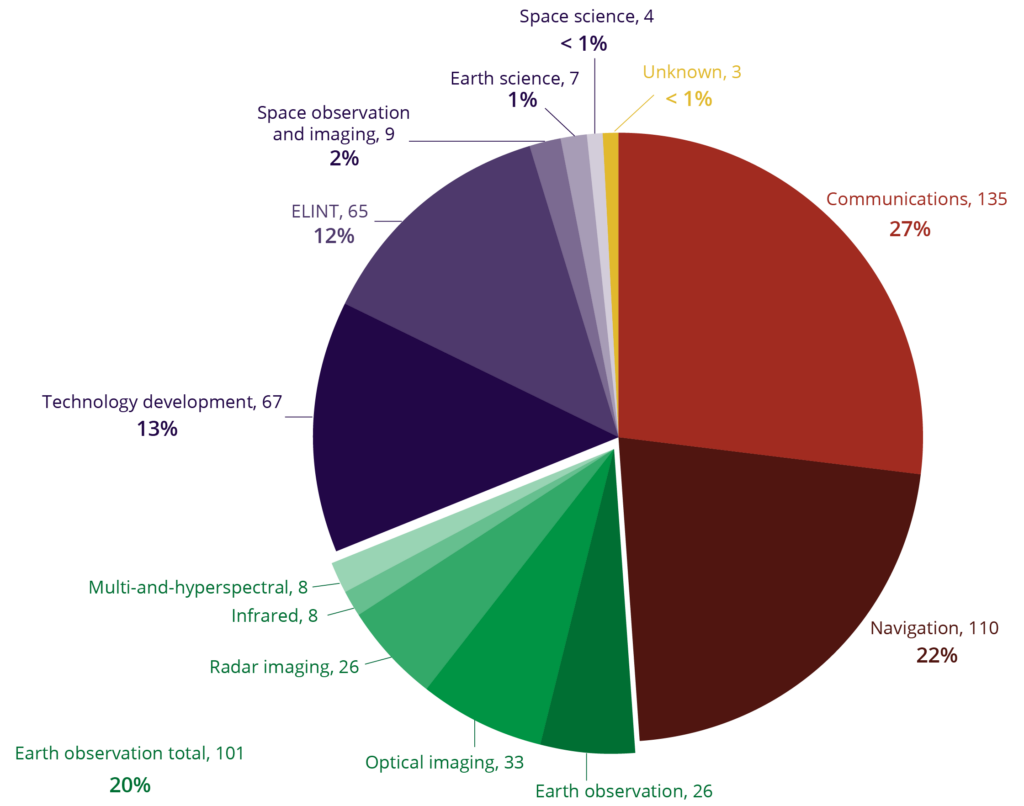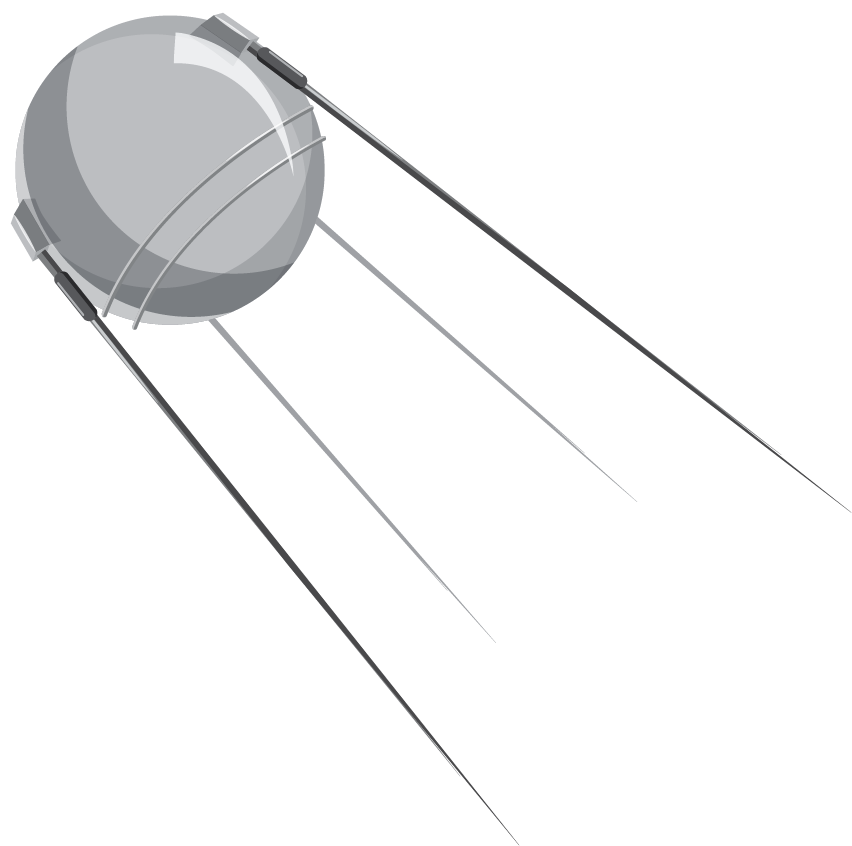ABOUT
This issue guide is focused on the use of space systems to support military activities on Earth. (For information on the potential use of force or warfighting in outer space, explore Issue Guides related to the security of outer space).
By introducing satellite imagery and space-based electronic intelligence collection, the space age broke new ground in intelligence, surveillance, and reconnaissance systems. Satellite communications have also provided extraordinary new capabilities for real-time command and control of military forces deployed anywhere in the world. Military satellites perform navigation, communications, weather, and technology development missions, in addition to intelligence gathering. This use of space to increase the effectiveness of terrestrial military operations is known as space force enhancement.
Today, both dedicated and dual-use civilian satellite systems are used for terrestrial military purposes by modern militaries all around the world. Military actors also procure many commercial satellite services and data.
MILITARY USERS AND SPACE SECURITY
Many space systems that we rely on when conducting everyday activities – including global navigation and positioning, weather forecasting, and communications – were originally developed for military use. Today, systems such as GPS provide essential functions to both civilian and military users, and in some cases are integrated with critical civilian infrastructure on Earth.
Such passive use of space assets in support of terrestrial military capabilities has long been considered peaceful. Indeed, military capabilities such as missile warning and national technical means of verification for arms control can help to provide strategic stability. However, dependence on military space systems, the vulnerability of these systems to a range of interference and negation capabilities, and the extension of strategic relationships and alliances to include the use of space-based assets and defence activities all raise the prospect that conflict on Earth will spill into space (see Issue Guide on warfighting in outer space).
TYPES OF MILITARY SATELLITES
Military satellites have historically been used to provide data and services in support of terrestrial military activities. The primary functions of military satellites include:
• The provision of dedicated and often more secure strategic and real-time tactical communications capabilities to armed forces. Some satellites transmit data from other types of satellites back to Earth. Global satellite communications require an extensive network of satellites; few states have such dedicated military capability.
• Reconnaissance – capturing images of Earth with optical, radar, infrared, and multi-and-hyperspectral sensors.
• Navigation and weapons targeting made possible with Global Navigation Satellite Systems (GNSS) such as GPS that provide precise global positioning data.
• Weather information and forecasting. With a few exceptions, most states now rely on civilian capabilities for this service.
• Signals intelligence (SIGINT), which is used to intercept and collect communications, radar, and other electronic signals (ELINT).

Space-based space surveillance capabilities do not focus on Earth, but monitor the space environment, including other satellites, and in same cases can inspect satellites.
SNAPSHOT OF MILITARY SATELLITES IN ORBIT
Of the more than 3,000 active satellites currently listed in the Union of Concerned Scientists Satellite Database (updated to August 2020), 501 are publicly identified as having a military function.

These figures only capture part of the story. Almost an equal number of satellites – 451 – are listed as “government” and may have both civil and military functions. China, in particular, identifies almost all of its 103 satellites as “government.”
HOW MANY MILITARY USES OF OUTER SPACE CHANGED OVER TIME?
Military activities in outer space began during the Cold War. With the launch of the Soviet Union’s Sputnik 1 satellite in 1957, the principle of the “freedom of space” came into practice. At first, only the militaries of the United States and the Soviet Union made use of space applications, mainly to support reconnaissance, communications and missile early warning functions.
The first military satellites, including the United States’ CORONA Project and the Soviet Union’s Zenit satellites, were photo reconnaissance satellites that captured images of enemy territory, often of military installations. Communications satellites, including the Soviet Molniya satellites and the U.S. Milstar, were then developed to reduce reliance on vulnerable undersea cables. Early warning satellites, such as the U.S. Missile Defense Alarm System (MIDAS) (later replaced by the Defense Support Program) and the Soviet Oko satellites, were developed to detect the launch of ballistic missiles or satellites, or even nuclear explosions.
Operation Desert Storm, the combat phase of the first Gulf War in 1991, is known as both the first “information war” and the first “space war,” and illustrates the growing reliance of militaries on space-based assets, not only for strategic support but to directly control and enable the use of force throughout the world.
Specifically, the United States-led operation against Iraq was characterized by the revolutionary use of the Navstar GPS satellite constellation to navigate troops through the desert, detect and locate enemy targets, and launch precision strikes using cruise missiles, stealth bombers, and new laser guided bombs. Since then, many more states have come to depend on space-based military systems to support the use of force on Earth.

Today, three global navigation satellite systems provide military services: the U.S. GPS, Russian Glonass, and Chinese BeiDou.
Among the most advanced militaries, space-based data and services are now integrated into almost every military function. In addition to precision targeting, this includes command, control, communications, computers, intelligence, surveillance, and reconnaissance (C4ISR) capabilities. Space is now essential to enabling military activity across all other domains.
A growing number of states are now creating dedicated space forces, commands, and other military space units, which include:
• The United States Space Force
• The Space Command of the French Air Force
• Japan’s Space Operations Squadron within the Japan Air Self-Defence Forces
• The Indian Defence Space Agency
• China’s Strategic Support Force
• The Russian Space Forces within the Russian Aerospace Force. This development signals the changing nature of military operations in outer space from support for terrestrial operations to the potential for warfighting or defensive operations. (For more information, see the Issue Guide on warfighting in outer space.)
WHO OPERATES MILITARY SATELLITES?
The number of states that own and operate satellites dedicated to military functions is growing. Iran’s first military satellite was launched in 2020.
As of July 2020, the satellite database of the Union of Concerned Scientists indicates that 29 states operate satellites with dedicated military or dual-use functions: Australia, Belgium, Brazil, Canada, Chile, China, Colombia, Denmark, Egypt, France, Germany, Greece, India, Iran, Israel, Italy, Japan, Luxembourg, Mexico, Qatar, Russia, South Africa, South Korea, Spain, Sweden, Turkey, United Arab Emirates, United Kingdom, United States.
Most dedicated military satellites are operated by the United States (204), China (114), and Russia (104).
China’s space-based military capabilities are almost certainly greater than the number of military satellites suggests, because China seldom distinguishes between civilian and military users of its satellites. All three states have developed military satellites for communications, different types of Earth observation satellites for reconnaissance, navigation satellites, and satellites that provide data for meteorology and signals intelligence. All three are also pursuing more advanced military capabilities on-orbit, such as rendezvous and proximity operations. Spending more than $25-billion per year on military satellites, the United States far outspends any other state; China is a distant second.
Many states with smaller space programs use data and capabilities derived from civilian satellites for military and national security purposes. Some militaries also buy commercial satellite services, notably Earth imaging and communications capabilities.
States are also accessing a growing number of space-based capabilities by forming strategic partnerships and alliances. For example, many U.S. allies make use of the military functions of the GPS system, and cooperate with partner states on the Advanced Extremely High Frequency (AEHF) and Wideband Global SATCOM military communications programs. In 2018, Pakistan became the first foreign state to access China’s BeiDou GNSS military service, through China’s regional Belt and Road infrastructure program.
WHAT IS DRIVING THE CHANGES IN THE USE OF SPACE BY MILITARY ACTORS?
Regional geopolitical tensions are encouraging military actors, particularly in Asia and the Middle East, to use space in new ways. In recent years, both Japan and India have broadened their space programs from exclusively peaceful, civilian uses to include dedicated military capabilities and organizations. Growing strategic competition among the most powerful states and the central role that space systems occupy across all military domains also drives development in military space capabilities.
However, other changes are also important. The ability to deploy advanced capabilities on smaller satellites is also facilitating increased use. The use of more, smaller satellites that can more easily be replaced and updated is a strategic focus of the U.S. military. But this shift is also making the use of outer space more accessible, including for military users. For example, military CubeSats – miniature satellites made up of a series of 10 cm × 10 cm × 10 cm cubic units – were launched by Mexico (Painani 1) and Sweden (SPARC 1) in 2019.
New military priorities also drive change. For example, a growing number of states are deploying satellites to fill in capability gaps in the Arctic, which global warming is making more available for human activities. In the last few years, Canada, Norway, Russia, Denmark, and the United States have all launched military satellites to provide Arctic capabilities, with a focus on communications and Earth imaging.
Many states want strategic independence in space. More European states, for example, are pursuing both independent and cooperative capabilities in space to be certain of access to key capabilities. The adoption of the European Union Global Strategy for Foreign and Security Policy led in 2017 to an agreement on Permanent Structured Cooperation (PESCO) on security and defence. This joint military program invests in equipment, research, and, among other developments, space activities such as ballistic missile early warning systems and military space situational awareness (SSA) capabilities, as well as the ability to use the European Space Agency’s civilian GNSS system for military purposes.
GOVERNANCE
There are no laws or rules specific to the operation of military satellites. The Outer Space Treaty (OST) serves as the primary basis for legal order in the space environment, establishing outer space as a domain to be used by all humankind for peaceful purposes. Military installations, activities, and manoeuvres are banned on the Moon and other celestial bodies. However, nonaggressive or passive use of space for military purposes – such as the operation of satellites – has long been accepted as “peaceful” in this context.

Other international treaties that govern activities in outer space also apply to military actors, but are not always obeyed. The Registration Convention requires states to inform the United Nations about objects placed into orbit. However, many military satellites are registered with inadequate information or are not registered at all.
The International Telecommunications Union (ITU) regulates the use and coordination of radio telecommunications. Article 45 of the ITU constitution requires states “not to cause harmful interference” to communications in space. However, Article 48 exempts military communications from ITU regulations. This loophole has been extensively exploited to exclude many satellites from ITU oversight, including some civilian and commercial satellites. The ITU now specifies that an Article 48 exemption is limited to satellites operated only for “military use.”
New space governance mechanisms that focus on safety and sustainability in outer space also apply to military activities. The Guidelines for the Long-term Sustainability of Outer Space Activities, adopted by the UN Committee on the Peaceful Uses of Outer Space (COPUOS) in 2019, indicate that the “interests and activities of States and international intergovernmental organizations in outer space, as they have or may have defence and national security implications, should be compatible with preserving outer space for peaceful exploration and use.”
CHALLENGES
Blurred Boundaries
While the passive operation of military satellites has long been deemed peaceful, this capability remains a factor in growing military competition in space, which is, in turn, linked to the testing of weapons capabilities and, in some cases, a shifting perception of space not as a peaceful domain but as a warfighting domain (see Issue Guides related to warfighting and ASAT weapons). The concern here is that the boundary between peaceful and non-peaceful use is not clear. As more states invest in military capabilities in space, this boundary may become blurrier.
The growing dependence on space-based assets for military and defence purposes increases the chance that conflict will escalate into space. How international law would work in such an event is not clear. Two legal manuals on the application of international law to crises and conflict in space (MILAMOS and Woomera) are currently being developed to respond to these challenges.
The dual-use nature of satellite systems – including the heavy civilian use of some critical military systems such as GPS and other GNSS systems – also raises concerns about the protection of critical civilian services in the event of conflict.
Poor Transparency
Many states fail to publicly acknowledge the military nature of registered national satellites. Many fail to disclose the launch of military satellites. The publicly available database of orbital information that is maintained by the U.S. military has historically omitted most U.S. classified satellites. In recent years, however, there has been greater transparency.
In 2013, the UN Group of Governmental Experts on Transparency and Confidence-building Measures in Outer Space Activities sought to bring greater transparency to military space activities. It recommended an exchange of information on national space policy and goals, including military space expenditures, outer space activities aimed at risk reduction, and visits to space launch sites and facilities.
States are not obliged to agree to these measures. Nor is it clear how such measures would be implemented. And so, progress remains slow.
RESOURCES
Melissa de Zwart, “International Space Law and Military Uses of Outer Space,” Bulletin (Law Society of South Australia), March 2020, https://search.informit.com.au/documentSummary;dn=036278413666167;res=IELHSS.
European Space Policy Institute, “Europe, Space and Defence,” ESPI Report 72, February 2020, https://espi.or.at/publications/espi-public-reports/send/2-public-espi-reports/502-europe-space-and-defence.
Steven Freeland, “Peaceful Purposes? Governing the Military Uses of Outer Space,” European Journal of Law Reform, March 2015, https://papers.ssrn.com/sol3/papers.cfm?abstract_id=2899901.
Larry Greenemeier, “GPS and the World’s First ‘Space War,’” Scientific American, February 8, 2016, https://www.scientificamerican.com/article/gps-and-the-world-s-first-space-war/#:~:text=Photo%20by%20Roland%20Gautier%2C%203AD,Iraqi%20troops%20out%20of%20Kuwait.
Mian Zahid Hussain &Raja Qaiser Ahmed, “Space Programs of India and Pakistan: Military and Strategic Installations in Outer Space and Precarious Regional Strategic Stability,” Space Policy, February 2019, https://www.sciencedirect.com/science/article/abs/pii/S0265964617300929.
McGill Centre for Research in Air and Space Law, “Manual on International Law Applicable to Military Uses of Outer Space,” McGill University, 2020, https://www.mcgill.ca/milamos.
Cassandra Steer, “Global Commons, Cosmic Commons: Implications of Military and Security Uses of Outer Space,” Georgetown Journal of International Affairs,” Winter/Spring 2017, https://papers.ssrn.com/sol3/papers.cfm?abstract_id=3031086.
Union of Concerned Scientists, UCS Satellite Database, updated August 1, 2020, https://www.ucsusa.org/resources/satellite-database.
The University of Adelaide, “The Woomera Manual,” May 29, 2020, https://law.adelaide.edu.au/woomera.
Sam Wilson, “Japan’s Gradual Shift toward Space Security,” The Diplomat, May 6, 2020, https://thediplomat.com/2020/05/japans-gradual-shift-toward-space-security.

